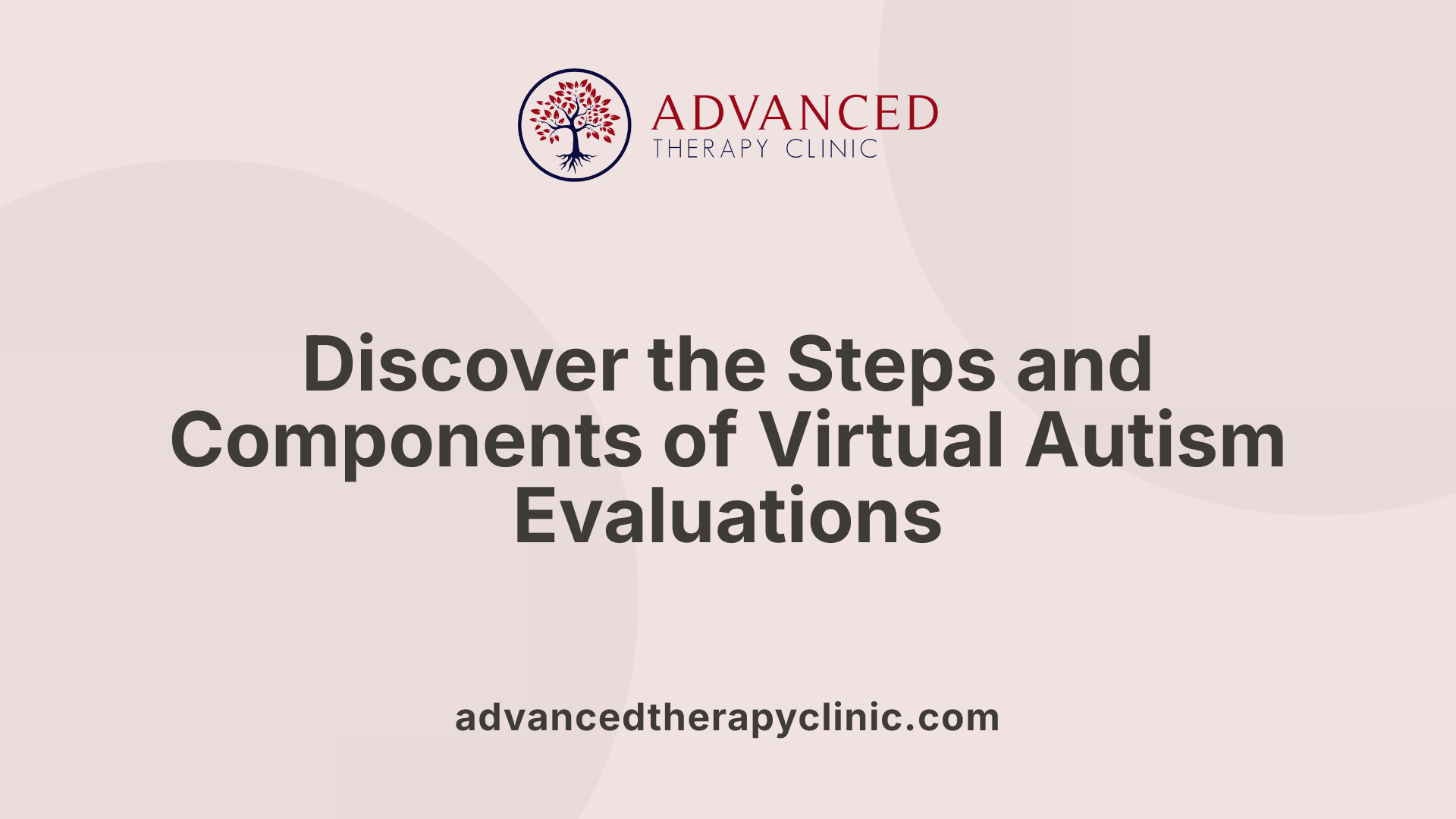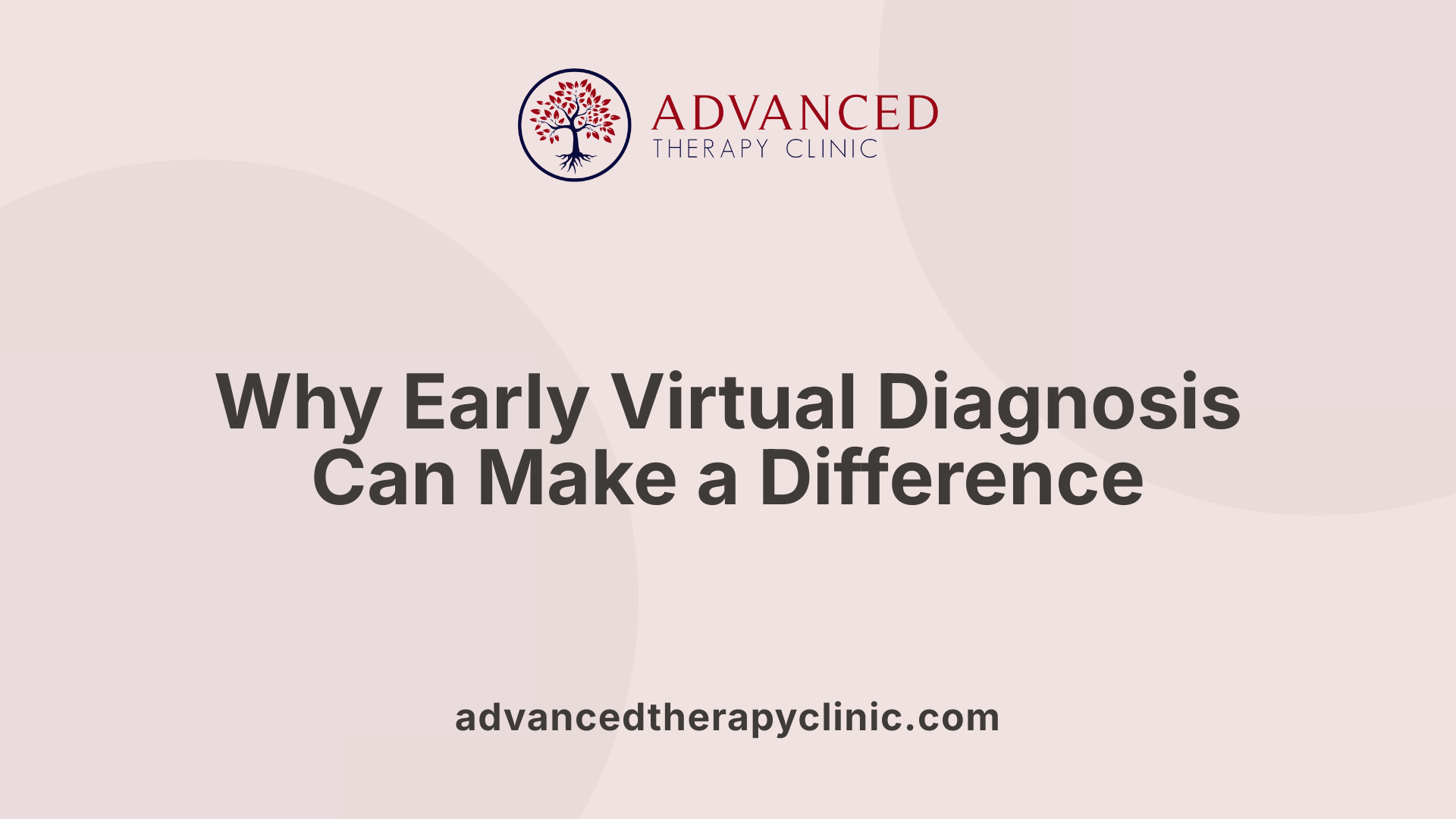Virtual Autism Assessment


Revolutionizing Autism Evaluation in the Digital Age
The emergence of virtual autism assessments has transformed how clinicians diagnose and support individuals on the autism spectrum. Using secure, telehealth-based platforms, providers deliver comprehensive, neuro-affirming evaluations that cater to children and adults alike. This shift not only ensures accessibility and convenience but also maintains diagnostic accuracy and fosters early intervention, crucial for improving life outcomes for those with ASD.
Understanding What a Virtual Autism Assessment Entails

What is involved in a virtual autism assessment and what is the process?
A virtual autism assessment is a comprehensive evaluation conducted via telehealth, allowing licensed professionals to diagnose autism spectrum disorder (ASD) remotely. The process begins with initial contact, where families fill out pre-assessment questionnaires online, verify insurance coverage, and schedule appointment times. These assessments are typically split into multiple sessions that may range from around 20 minutes to several hours, depending on the package chosen.
During the evaluation, psychologists review developmental histories, observe behaviors through interactive activities, and gather information from caregivers or the individual being assessed. Observations often include structured play or social engagement exercises designed to elicit behaviors relevant for diagnosis. The professionals look at communication skills, social interactions, sensory responses, and behavioral patterns.
The assessment includes a series of interviews, behavioral observations, and standardized tools such as the Autism Diagnostic Observation Schedule (ADOS-2), adapted for remote use, like Tele-ASD-Peds. This combination of methods ensures a thorough understanding of the individual's needs.
Once evaluations are completed, a feedback session is scheduled, during which the providers discuss their findings, potential diagnoses, and recommendations. A detailed report, often signed and official, is delivered within two weeks, providing families with clarity and guidance for next steps. These reports help in forming personalized intervention strategies, accessing support services, and fostering self-awareness. The entire process emphasizes flexibility, accessibility, and confidentiality, making it a practical option for many families seeking an accurate diagnosis without the need for in-person visits.
Types of assessments offered
Prosper Health and similar clinics offer a variety of assessment packages tailored for different needs, including:
| Assessment Type | Description | Duration | Additional Features |
|---|---|---|---|
| Brief Report | Focused evaluation for quick insights | Multiple sessions, around 2-3 hours total | Basic diagnosis with summary report |
| Full Report | In-depth evaluation with detailed analysis | Several sessions, up to a full day | Comprehensive insights, recommendations |
| Comprehensive | Extensive assessment including developmental and behavioral analysis | Several hours over multiple days | Personalized intervention plan, ongoing support |
All assessments incorporate pre-assessment questionnaires, multiple interviews, behavioral observations, and professional reports. Some services also offer accommodations for educational or workplace placements.
Involvement of licensed professionals
All assessments are conducted or overseen by licensed clinical psychologists trained specifically in recognizing autism in adults and children. These professionals use evidence-based, validated tools and stay current with the latest research. They are trained to consider cultural background, gender, and masking behaviors that might influence diagnostic outcomes.
Additionally, many of these clinics participate in ongoing training, including programs like the Virtual Evaluation Developmental Assessment (VEDA), which helps clinicians improve telehealth assessment methods. This multidisciplinary expertise ensures accuracy, sensitivity, and a neurodiversity-affirming approach throughout the diagnostic process.
| Key Partnering Features | Description | Sources |
|---|---|---|
| Telehealth Platform | Secure, user-friendly system for remote sessions | Prosper Health, Avela Health |
| Diagnostic Tools | ADOS-2, Tele-ASD-Peds, standardized assessments | Clinical guidelines |
| Professional Training | Specialized in adult and virtual assessments | Yale, Northwestern, VEDA |
Understanding the virtual autism assessment process highlights its accessibility, flexibility, and adherence to professional standards, providing families and individuals with reliable insights and pathways to support.
The Process of Scheduling and Completing a Virtual Evaluation

How can I schedule and complete a virtual autism evaluation?
To begin the process, reach out to a qualified provider like Prosper Health or Avela Health, either directly via their website or through a healthcare referral. The initial step involves filling out a pre-assessment questionnaire that helps the provider understand your needs and determine the appropriate testing options.
Next, you'll discuss insurance coverage—many providers accept Medicaid, TRICARE, and private insurance plans—making the process more accessible and affordable.
Once your preliminary paperwork is complete, scheduling your evaluation is straightforward. Most providers offer flexible online scheduling options, allowing you to book two or more remote appointments that include clinical interviews and behavioral observations.
The assessments are conducted in your home environment, typically via secure video conferencing platforms. These sessions may involve computer-based tasks, caregiver interviews, and activities designed to observe behaviors related to autism.
After completing the assessments, the provider reviews all collected information. The results are then compiled into a comprehensive report, usually delivered within a few weeks.
Following your evaluation, you'll have the opportunity for a follow-up session to discuss the results in detail. During this meeting, the provider will explain the findings, outline next steps, and recommend any necessary interventions or supports.
This ordered, remote process ensures that participants receive accurate diagnoses and personalized recommendations without having to leave their homes or wait extended periods for appointments.
Benefits and Significance of Early Diagnosis through Virtual Assessments

What are the benefits of early autism diagnosis via virtual assessments?
Early diagnosis of autism through virtual assessments offers many important advantages. One of the most significant benefits is the ability to start targeted interventions sooner, which can lead to better developmental outcomes. When autism is identified early, children can benefit from specialized therapies, educational plans, and support services that help them navigate social, emotional, and language skills.
Virtual assessments are often as accurate as traditional in-person evaluations. They utilize validated tools like the Autism Diagnostic Observation Schedule (ADOS-2) adapted for telehealth, and involve thorough interviews, observations, and standardized assessments conducted remotely. These evaluations are delivered by trained clinical psychologists who understand the nuances of adult and pediatric autism, ensuring precise diagnoses.
Another major advantage is accessibility. Families living in rural or underserved areas no longer need to travel long distances or wait months for appointments. Telehealth makes it easier for families to access timely evaluations from the comfort of their homes, reducing stress and logistical challenges.
In addition, virtual assessments allow clinicians to observe children in their natural environments, which can provide more accurate insights into their behaviors and social interactions. This context-aware approach often results in a clearer understanding of their needs.
Early diagnosis also facilitates access to educational accommodations and community resources. It promotes early engagement in interventions that capitalize on the brain’s plasticity, leading to improved communication, social, and emotional skills over time.
Overall, virtual autism assessments streamline the diagnosis process, reduce delays, and enable families to start supportive measures earlier. This proactive approach supports healthier developmental trajectories and enhances quality of life for autistic individuals and their families.
| Benefit | Description | Additional Info |
|---|---|---|
| Developmental advantage | Early intervention improves outcomes | Engages therapies during critical growth periods |
| Increased access | Reaches remote or underserved areas | No need for travel, reduced wait times |
| Convenience | Conducted from home | Flexible scheduling and shorter sessions |
| Accurate diagnosis | Well-established telehealth tools | Utilizes standardized, validated assessments |
| Support and resources | Enables timely access to services | Facilitates tailored educational and community support |
Virtual Assessments versus Traditional Evaluations: A Comparative Look

How do virtual autism assessments compare with traditional in-person evaluations?
Recent research and clinical practices demonstrate that virtual autism assessments, including adaptations like Tele-ASD-Peds and online versions of the Autism Diagnostic Observation Schedule (ADOS-2), tend to produce results comparable to those obtained through conventional in-person evaluations. Several studies have shown that the diagnostic confidence and accuracy over telehealth range from 80% to 91%, with sensitivity scores often reaching up to 100% and specificity close to or above 68.75%.
These virtual assessments present notable advantages, especially in terms of accessibility and convenience. Patients—adults, children, and their families—can undergo evaluations from the comfort of home, eliminating travel time and reducing logistical barriers. This flexibility also lessens anxiety associated with clinical visits, providing a less stressful environment that can sometimes lead to more genuine behavior during assessments.
Despite their promising accuracy, virtual assessments do face certain limitations. The inability to physically interact or observe certain subtle behaviors in real-time can impede some aspects of comprehensive evaluation. For instance, physical interaction allows clinicians to gauge motor skills and sensory responses directly, which can be essential in nuanced diagnostic processes.
While these remote evaluations utilize validated tools and have been backed by peer-reviewed research, they are not complete replacements for all elements of in-person assessments. They work best when used as part of a multi-faceted approach, especially in areas where access to specialized clinics is limited.
In summary, virtual autism assessments are a reliable and efficient alternative to traditional evaluations when conducted under proper protocols and conditions. They provide accurate results for many, but some diagnostic features still benefit from face-to-face observation, highlighting the importance of personalized assessment strategies.
Understanding Signs and Symptoms of Virtual Autism and Excessive Screen Time
What are the signs and symptoms of virtual autism or behaviors associated with excessive screen time?
Virtual autism refers to autism-like behaviors in children that are often linked to high amounts of screen exposure during early childhood. Common signs include delayed speech and language development, which can make communication challenging for the child.
Children affected by virtual autism often exhibit social withdrawal, avoiding eye contact, and showing little interest in interacting with others. They may display hyperactivity, impulsivity, and have difficulty focusing or paying attention over time.
Behavioral issues such as irritability, mood swings, and repetitive behaviors are also typical. Some children prefer electronic devices over real-world activities, leading to limited physical activity and social engagement.
Early interventions are crucial. Reducing screen time and encouraging face-to-face interactions, play, and physical activities have been shown to significantly improve these symptoms. When children are supported with a balanced environment that fosters social and cognitive skills, many aspects of virtual autism can be reversed or lessened, improving overall development.
Research, Validity, and Effectiveness of Telehealth in Autism Diagnosis
How reliable and valid are telehealth diagnostics for autism?
Recent research shows that diagnosis of autism spectrum disorder (ASD) through telehealth methods is largely dependable. Studies report that the agreement between telehealth evaluations and traditional in-person assessments ranges from 80% to 92%. This indicates high consistency and suggests that remote assessments can be a credible option for many individuals.
Key assessment tools used in telehealth settings include behavioral observation measures like the BOSA (Brief Observation of Symptoms of Autism) and TELE-ASD-PEDS, which are specially adapted for online use. These instruments have demonstrated elevated levels of sensitivity and specificity, meaning they accurately identify true positives and true negatives. For example, validation studies have shown sensitivity ranges from 75% to 100%, and specificity from approximately 69% to 100%, depending on the tool and population.
Importantly, research focusing on toddlers and young children suggests that virtual assessments retain high diagnostic accuracy in early stages, which is crucial for early intervention.
Stakeholders, including clinicians and families, report high satisfaction with telehealth ASD assessments. They appreciate the convenience, reduced travel requirements, and the ability to observe behaviors in naturalistic settings during remote evaluation.
Nonetheless, some challenges remain. Variability in assessment procedures across different providers, occasional technological difficulties, and the need for further research to ensure accuracy across diverse populations are areas for ongoing improvement.
In sum, current evidence supports telehealth as a valid and effective modality for diagnosing autism, with promising implications for increasing access to timely evaluations.
The Broader Spectrum of Virtual Autism Evaluation Services
Several organizations now provide comprehensive virtual autism assessments, making diagnosis accessible regardless of location. Specialized clinics like Prosper Health and Avela Health conduct remote evaluations for both children and adults, utilizing secure online platforms and evidence-based tools developed for telehealth settings.
Providers offering these services include licensed psychologists, clinical psychologists, and interdisciplinary teams trained in neurodiversity-affirming care. They employ established assessment instruments such as the Autism Diagnostic Observation Schedule 2nd Edition (ADOS-2), Tele-ASD-Peds (a modified version of ADOS-2 for online use), and standardized questionnaires like the Vineland™ 3, Sensory Profile™ 2, and BASC™-3. These tools are administered remotely, often through video conferencing, enabling thorough behavioral observation and clinical interviews.
Beyond diagnostic evaluations, many providers offer additional services such as therapy, support groups, and ongoing consultation tailored for autistic adults and children. Some clinics focus exclusively on adult assessments, utilizing validated tools designed for older populations, and provide swift diagnosis—sometimes within just three days.
The process typically involves initial intake, detailed interviews, observation, and review, culminating in official reports that help families and individuals understand their strengths and challenges. Insurance coverage is often accepted, reducing the financial barrier to accessing timely diagnosis. These services are especially valuable for those in remote or underserved areas, ensuring early intervention and support for neurodivergent individuals.
| Provider Type | Assessment Tools | Additional Services | Notes |
|---|---|---|---|
| Specialized clinics | ADOS-2, Tele-ASD-Peds, Vineland™ 3 | Therapy, support groups, ongoing support | Rapid diagnosis, telehealth accessible |
| Pediatricians | M-CHAT, PEDS | Early screening and referral | Suitable for early detection |
| Licensed psychologists | Standardized questionnaires, observations | Customized interventions, counseling | For children and adults |
| Adult-focused services | Adult-validated tools, telehealth methods | Diagnostic and clinical support | Focused on neurodivergent adults |
Resources for virtual autism assessment are expanding, providing hope for early diagnosis and tailored support through accessible, trusted telehealth options.
Empowering Informed Decisions and Support Through Virtual Evaluation
Virtual autism assessments represent a significant advancement in neurodiversity-affirming care, offering accurate, accessible, and timely diagnoses for children and adults. By utilizing evidence-based tools and telehealth innovations, providers can deliver comprehensive evaluations without the need for in-person visits, reducing barriers and wait times. Early and precise diagnosis empowers families and individuals to access tailored interventions, educational supports, and community services, fostering acceptance and improving quality of life. As research continues to validate the effectiveness of virtual assessments, these services will play an increasingly vital role in promoting neurodiversity and facilitating ongoing support for all neurodivergent individuals.
References
- Virtual Autism Assessments - GRASP
- Adult Autism Diagnosis and Testing - Prosper Health
- Virtual Autism Assessments - Dr. Mark Bowers - United States
- Project ECHO: Telehealth Autism Assessment
- Virtual Autism: What is it and How is it Assessed?
- A scoping review of telehealth diagnosis of autism spectrum disorder
- Virtual Autism Clinic - Neuropsychology Concierge
- Prosper Health: Online Adult Autism Therapy and Testing Services
Recent articles

Expressive Speech Delay 2-Year-Old
Understanding and Addressing Expressive Speech Delay in Toddlers

How Speech Recognition Works
Unlocking the Power of Speech Recognition in Therapy and Healthcare

Autism and Head Size
Understanding the Complex Relationship Between Autism and Head Size

Occupational Therapy in Autism
Enhancing Independence and Quality of Life Through Occupational Therapy in Autism

Do Autistic People Understand Sarcasm?
Navigating the Nuances: Understanding Sarcasm and Social Communication in Autism

Autism Routines
Crafting Effective Daily Structures for Children with Autism

